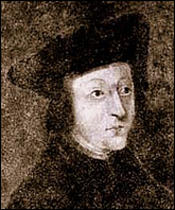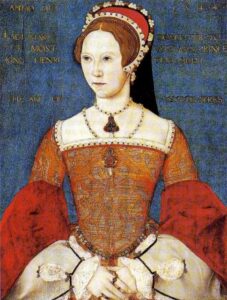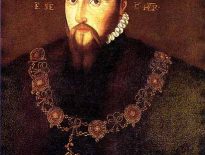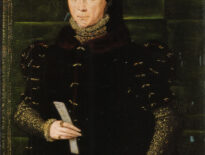 On this day in Tudor history, 21st January 1556, former imperial ambassador, Eustace Chapuys, died in Louvain (Leuven) in Belgium, the place he had retired to in 1549. He was laid to rest in the chapel of Louvain College, the college he had founded following his retirement.
On this day in Tudor history, 21st January 1556, former imperial ambassador, Eustace Chapuys, died in Louvain (Leuven) in Belgium, the place he had retired to in 1549. He was laid to rest in the chapel of Louvain College, the college he had founded following his retirement.
Chapuys, who was born between 1490 and 1492 and was the second son of Louis Chapuys, a notary of Annecy, in the duchy of Savoy, joined the imperial service in 1527. Two years later, in September 1529, he arrived in England to act as advisor to the emperor’s aunt, Catherine of Aragon, in the negotiations regarding the annulment of her marriage to Henry VIII. He was her link to the emperor and to Rome. He became Catherine’s champion, preparing Catherine’s formal protest when Cranmer summoned her to his special court in 1533, a court that ruled her marriage to the king invalid, and in 1534 he acted for Catherine’s daughter, Mary, when he drew up her protest against the Act of Succession. He wasn’t only their staunch supporter and go-between, he became their friend, and I’d go as far as to say that he became a father figure to Mary.
Mary was in an awful position. The daughter Henry VIII once referred to as the pearl of the world was now a pariah. She’d been banished from court, made illegitimate, removed from the succession, rejected by her father and refused access to her mother, and then her household was dismantled and she ended up having to serve her young half-sister, Elizabeth. It is little wonder that Mary’s health suffered as a result. She was recorded as being ill with stomach pains and not being able to keep food down in 1531, and in 1534, royal physician Dr William Butts recorded that she was “diseased in her head and stomach”. It was rumoured that she’d been poisoned, but Dr Butts believed that she’d reacted badly to pills given to her by an apothecary.
Her ill-health, her mental state and rumours that Queen Anne Boleyn was plotting to have Mary murdered, led to Chapuys fearing for the princess’s safety. If only she could get out of England and be safe in the empire! In January 1535, Mary’s cousin, Emperor Charles V, wrote to Chapuys about a potential marriage match between Mary and King James V of Scotland. The Scottish king supported the idea, but believed “it impossible that she should be delivered to him”. The emperor wanted Chapuys to “consider if there be any means of getting away the said Princess”. Chapuys mentioned the idea to Mary, who was willing, wanting nothing more than to be beyond the sea. However, he also realised how hazardous the plan was, something that might put her off, and difficult, due to the fact that she was closely guarded.
 Then there was the fact that Henry VIII was suspicious. In February 1535, Mary became ill, so ill that physicians stated that she was “in great danger of her life”. They put her illness down to “distress and sorrow” and recommended moving her nearer to her mother, who wanted to nurse her, as the princess could “very easily cured if she were put in some place where she could take pleasure and have exercise”. The king would not consider moving her nearer her mother, 1) because there was no way he was rewarding his ex-wife and wayward daughter for their defiance, and 2) because he believed that she could easily escape if she was moved, stating that he knew the emperor “would be glad to withdraw the said Princess somehow”. Chapuys set about assuring the king that, and I quote, “there was no probability that your Majesty would attempt to steal away the said Princess” while planning the escape, writing to the emperor: “As to getting her away from here, if the King do not remove her from hence, it could be accomplished by having a pinnace on the river and two armed ships at the mouth of the river; at least I could find means to get her out of the house almost at any hour of the night…”
Then there was the fact that Henry VIII was suspicious. In February 1535, Mary became ill, so ill that physicians stated that she was “in great danger of her life”. They put her illness down to “distress and sorrow” and recommended moving her nearer to her mother, who wanted to nurse her, as the princess could “very easily cured if she were put in some place where she could take pleasure and have exercise”. The king would not consider moving her nearer her mother, 1) because there was no way he was rewarding his ex-wife and wayward daughter for their defiance, and 2) because he believed that she could easily escape if she was moved, stating that he knew the emperor “would be glad to withdraw the said Princess somehow”. Chapuys set about assuring the king that, and I quote, “there was no probability that your Majesty would attempt to steal away the said Princess” while planning the escape, writing to the emperor: “As to getting her away from here, if the King do not remove her from hence, it could be accomplished by having a pinnace on the river and two armed ships at the mouth of the river; at least I could find means to get her out of the house almost at any hour of the night…”
Further plans were discussed in a letter dated 4th March, with Chapuys mentioning that Mary could even be rescued from the Tower of London, if she was taken there, if everything was put in place according to his plan, i.e. a suitable vessel to row her along the Thames to ships waiting for her at the mouth of the river. It was a waiting game, for it was rumoured that Mary was going to be moved. They just had to wait for that to happen and then they could act accordingly.
Sadly, the plan failed. On 5th April, Chapuys reported to the emperor that Elizabeth, and therefore Mary, had been removed from Greenwich, which, of course, had been conveniently located on the Thames, just when a Spanish galleon was on the other side of the river and other Spanish ships nearby. Chapuys wrote that although the princess had been willing to escape, “her sudden departure broke off the enterprise” and also that he hadn’t dared commit himself fully to the plan “not having commandment from your Majesty”. Mary, he said, was still committed to the escape plan so Chapuys assured the emperor that he would continue plotting and that things would be made easier when the finer weather arrived as they could take her by surprise while she was out walking, so it would look as if she didn’t know anything about it. He noted that it was a hazardous plan, but that her new lodgings meant “it would be easier to save her than it was at Greenwich, for we could put her on board beyond Gravesend, past the danger of this river.”
There are further letters going well into the summer of 1535, showing that Mary was still enthusiastic about the plan, as were Chapuys and the emperor. However, on 13th September 1535, in a letter regarding the royal physicians’ concerns about Mary’s health worsening if that winter she was kept in servitude and captivity, rather than being with her mother and having “recreation”, Chapuys ended by saying, “I have laboured long for this end, but to no purpose.” His planning had been futile, it had got them nowhere, but Chapuys actually didn’t give up. Perhaps the death of Catherine of Aragon on 7th January 1536 spurred him into action once more. And Mary was even more desperate, with Chapuys recording, “ her anxiety to escape from her present unhappy situation is so great that I think if I told her to go to sea in a sieve she would do it”. On 17th February 1536, Chapuys explained that the plan was to provided Mary with a sleeping draught that she could administer to the women placed about her. Once that took effect, she could then escape out of the garden door. The only problem then was the long ride to Gravesend, so he considered that it might be better to wait until Easter, when she might be moved somewhere easier and might not be so closely guarded.
Imagine plotting to rescue a princess under constant surveillance, where every move could lead to execution. Chapuys planned everything—from secret river routes to drugged guards! Wow! Too often Chapuys is regarded only as an ambassador sharing Tudor court gossip, when actually he was ready to risk everything for Princess Mary.
Again, his carefully laid plans didn’t come to anything, perhaps because Chapuys began to hear rumours of Anne Boleyn’s impending fall. And fall, she did, being executed as a traitor on 19th May 1536. The woman who’d caused Catherine and Mary’s banishment from court was suddenly gone and Mary assumed that with her stepmother out of the way, her father would welcome her back to court with open arms, that her time of danger was over.
Nope!
Henry VIII was not interested in a reconciliation until she accepted the annulment of her parents’ marriage, her illegitimate status and his status as supreme head of the church in England. It was non-negotiable. And rather than kindly pointing this out to Mary, he sent members of his council to bully her. A horrified Chapuys recorded their visit in a letter to the emperor, telling of how one even said that if she were any other man’s daughter then “he would beat her to death, or strike her head against the wall until he made it as soft as a boiled apple; in short that she was a traitress, and would be punished as such”. Mary was being called a traitor by members of the royal council, and the punishment for treason was death.
Were these empty threats? Was Mary’s life really in danger? Well, it’s impossible to know for sure, but after this visit and having heard that one of the princess’s servants had been imprisoned at Thomas Cromwell’s lodging, Chapuys believed Mary to be at risk, and there was no time for an escape plan. The danger was very real and present.
The ambassador advised Mary to “make all manner of sacrifices” “in order to save her own life”. In what must have been the most heart-wrenching moment of her life, Mary signed the document, sacrificing her beliefs and pride for survival. And through it all, Chapuys stood by her, offering reassurance and reminding her that it was the only way to ensure her safety. Although it may well have saved her life and led to her being welcome at court once more, it cost Mary dearly. Chapuys described how, on signing the submission, Mary “fell suddenly into a state of despondency and sorrow”. She must have felt that she’d betrayed her mother and her faith. The fatherly Chapuys comforted her, explaining that it was what the emperor wanted and that the Pope would not hold it against her, that he would “highly approve of it under the circumstances”.
After receiving her submission, Mary’s father and his new wife, Jane Seymour, welcomed her back at court with open arms. Mary was safe and it was thanks to Chapuys. Chapuys wasn’t just an ambassador, was he? He was Mary’s protector, her confidant, and the closest thing to a father figure she had in those dark times. When her real father failed her, Chapuys was there fighting for her. I have a lot of time for Eustace Chapuys – not only are his dispatches a wonderful source for historians, he was a man of principle and a man who did his best by Catherine and Mary. He was there when they needed a supporter, he was their champion, and he should be remembered for that.



Leave a Reply